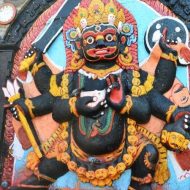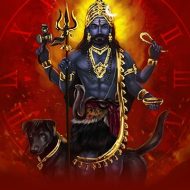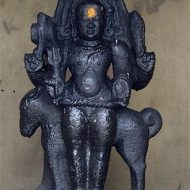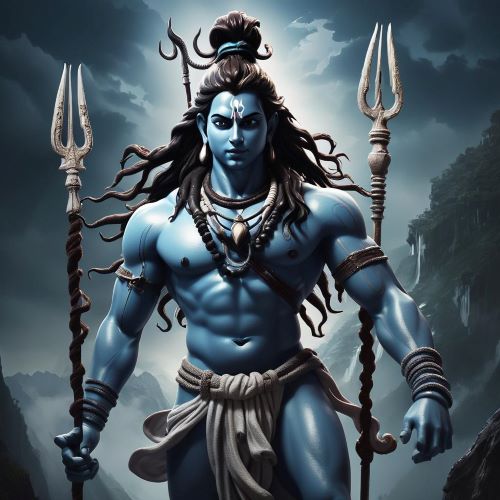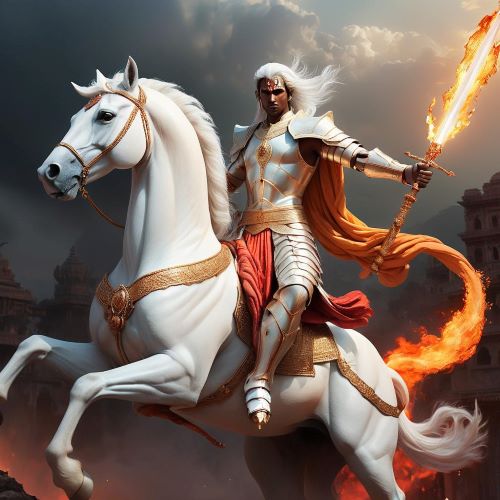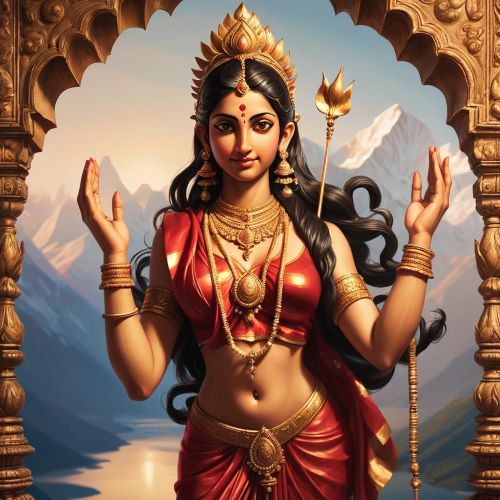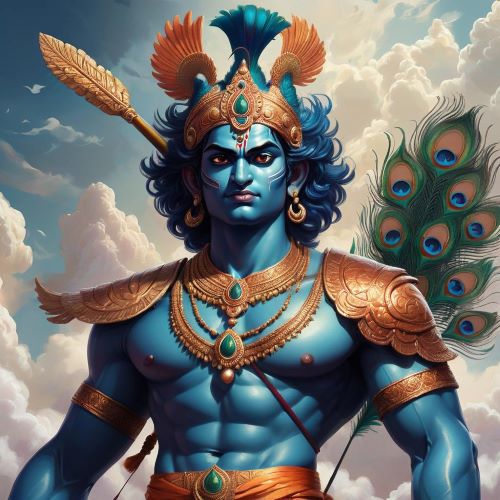Bhairava : The Ultimate Destroyer
Listen
At a glance
| Description | |
|---|---|
| Origin | Indian Mythology |
| Classification | Gods |
| Family Members | N/A |
| Region | India, Nepal |
| Associated With | Destruction, Tantric Sciences |
Bhairava
Introduction
In Hindu mythology, Bhairava is revered as one of the fiercest manifestations of Lord Shiva. Often depicted as a wrathful figure, his role extends beyond mere destruction to that of a guardian and liberator, embodying the complex interplay between creation and dissolution within the spiritual, philosophical, and ritualistic realms. Standing out in the vast pantheon of Hindu deities, Bhairava embodies both awe and terror as a ferocious manifestation of Lord Shiva. His form symbolizes the destructive and transformative forces that underpin the cosmic order.
Known also as Kala Bhairava, Bhairava is worshipped by Hindus and Buddhists alike. In the Shaivite tradition, Bhairava is a powerful manifestation or avatar of Shiva associated with annihilation. In the Kashmir Shaivism tradition, Bhairava represents the Supreme Reality, synonymous with Para Brahman. His fierce appearance—fiery eyes, garland of skulls, and intense presence—emanates both awe and reverence. Bhairava’s multifaceted nature, encompassing fierce protection and symbolism of time and death, makes him a captivating figure in Hindu mythology.
Physical Traits
Bhairava’s depictions often showcase his fearsome form with distinctive attributes. Adorned with a garland of skulls, he symbolizes dominion over death and impermanence. His eyes blaze with fiery intensity, simultaneously frightening and compelling. Often shown with a wrathful expression, bared fangs, and wild, standing hair, Bhairava’s complexion varies from dark blue to fierce red, reflecting the depth of his nature. His depiction may include multiple arms—four, eight, or even thirty-four—signifying boundless power. In some representations, Bhairava rides a dog, emphasizing his association with realms beyond the physical world. His attire is minimal, usually consisting of garlands of skulls and a coiled snake around his neck, emphasizing mortality and spiritual awakening.
Bhairava embodies his role as the annihilator of evil and ignorance with a dark complexion symbolizing the vast expanse of the cosmos. His untamed hair signifies freedom from worldly constraints, complemented by serpents and garlands of skulls that evoke both awe and reverence. The weapons he wields—trident, drum, sword, and skull bowl—each symbolize facets of his power and authority, further enhancing his formidable presence.
Family
Bhairava’s lineage is deeply rooted in the heart of the Hindu pantheon, directly tied to Lord Shiva, the supreme deity of destruction. Often regarded as an avatar or manifestation of Shiva himself, Bhairava’s mythological origin is attributed to Shiva’s wrathful aspect, emerging when he severed the fifth head of Lord Brahma, symbolizing the destruction of ignorance and ego. In some traditions, Bhairava is also linked with the goddess Shakti, embodying divine feminine energy and power.
Bhairava’s consort, Bhairavi, further accentuates his connection to the cosmic dance of creation and destruction. Together, they symbolize fundamental aspects of the universe, representing the potent interplay between masculine and feminine forces. Bhairava’s multifaceted nature offers devotees diverse qualities to connect with, ranging from guidance and protection to spiritual growth and transformation. Each aspect of Bhairava underscores the richness and depth of his symbolism within Hindu mythology, reflecting profound spiritual truths and pathways for seekers.
Other names
Bhairava, revered across various regions and texts within Hinduism, is known by a multitude of names that reflect different facets of his divine nature and cosmic roles. His epithets include Kala Bhairava (the Time-Controller), Asitanga Bhairava (dark-bodied Bhairava), and Ruru Bhairava (frightful Bhairava), each emphasizing unique aspects of his character and symbolism. Among these titles, Bhairava’s association with time, destruction, protection, and transformation is underscored, highlighting his significance in the cosmic order. His diverse forms, such as the eight Ashta Bhairavas representing different cosmic functions and directions, provide devotees with various avenues to connect with his energies based on their spiritual needs and aspirations.
In Hindu mythology, Bhairava’s lineage ties directly to Lord Shiva, often considered an avatar or manifestation of the supreme deity of destruction. According to legend, Bhairava emerged from Shiva’s wrathful form when he severed the fifth head of Lord Brahma, symbolizing the destruction of ignorance and ego. Bhairava’s association with Shakti, the divine feminine energy, further enriches his mythological narrative, showcasing his role in cosmic balance and the dance of creation and dissolution. His consort, Bhairavi, embodies the feminine principle and complements Bhairava’s fierce nature, representing the dynamic interplay of masculine and feminine energies within the universe.
Beyond Hinduism, Bhairava’s influence extends into Vajrayana Buddhism, where he is regarded as a fierce emanation of bodhisattva Mañjuśrī. Known by names like Heruka, Vajrabhairava, and Yamantaka, Bhairava represents the transformative power of wisdom and compassion in Buddhist tradition. His presence in multiple religious contexts underscores his universal significance as a symbol of protection, guidance, and the transcendence of worldly limitations. Across these traditions, Bhairava’s diverse names and forms unveil the depth of his character, offering devotees pathways for spiritual growth and enlightenment.
Powers and Abilities
Bhairava is celebrated for his formidable powers and divine abilities, particularly his mastery over time (Kala) and his pivotal role in overseeing the cosmic cycle of creation, preservation, and destruction. Legends speak of his wrath capable of vanquishing even the most formidable demons, underscoring his status as a guardian of cosmic order. Beyond his role as a destroyer, Bhairava is revered as a remover of obstacles and protector of his devotees, granting blessings that bestow protection, alleviate negativity, and offer liberation from the cycle of rebirth. Tantric traditions associate Bhairava with yogic practices, emphasizing the awakening of inner power and spiritual transformation through his blessings.
The essence of Bhairava’s nature lies in his capacity for destruction, which serves as a catalyst for transformation and renewal rather than mere annihilation. His symbolism, epitomized by a garland of skulls, embodies the inevitability of death and the transient nature of existence. Bhairava’s supernatural prowess extends to his dominion over time, reflected in his association with the cosmic cycles of creation and dissolution. Devotees seek his guidance and protection, believing in his ability to dispel fear, impart courage, and awaken spiritual enlightenment during rituals aimed at breaking curses or dispelling negativity.
Bhairava’s fearsome reputation stems from his ability to annihilate fear itself and safeguard devotees from formidable adversaries, including inner obstacles like greed, lust, and anger that hinder spiritual growth. As a deity who encompasses the creation, sustenance, and dissolution of life’s stages, Bhairava embodies the relentless rhythm of existence and the transformative power inherent in destruction. His presence resonates deeply in Hindu mythology, offering devotees a profound connection to divine protection and spiritual liberation.
Modern Day Influence
Bhairava holds a significant place in contemporary Hinduism, with his imagery prominently featured in temples across India, especially those dedicated to Lord Shiva. Devotees venerate Bhairava seeking protection, inner strength, and spiritual liberation. Tantric practitioners continue to revere Bhairava for his esoteric knowledge and spiritual potency, viewing him as a source of profound wisdom and transformative energy. Beyond religious contexts, Bhairava’s fearsome aspect has permeated popular culture, appearing in diverse artistic expressions like literature, art, and video games. His image serves as a reminder of the universe’s transformative power, both awe-inspiring and essential for continued existence.
Bhairava’s worship extends beyond India to countries like Nepal, Indonesia, Sri Lanka, and Japan, as well as within Tibetan Buddhism, highlighting his widespread influence across diverse cultural and spiritual landscapes. Numerous temples dedicated to Bhairava dot these regions, where devotees gather to celebrate festivals in his honor, seeking his blessings for protection and spiritual guidance. Bhairava’s teachings continue to inspire spiritual seekers, guiding them towards enlightenment and a deeper understanding of life’s mysteries.
In modern Hindu practice, Bhairava remains relevant through festivals like Kalashtami, dedicated specifically to honoring his fierce aspect and invoking his blessings for spiritual growth and protection. His iconography resonates in popular culture, depicted in various forms of art, literature, and cinema as a potent symbol of divine power and protection, capturing the imagination of artists, writers, and philosophers exploring themes of strength, time, and the essence of existence.
Related Images
Frequently Asked Questions
What is Bhairava the god of?
Who is Lord Bhairava wife?
What is the power of Bhairav?
Bhairav’s might rules time’s flow, a destroyer’s touch. He crushes demons, grants his own a crutch. Obstacles vanish with his fearsome stare, Tantrics seek his power, liberation to share.
Who defeated Bhairava?
In Hindu mythology, Bhairava isn’t typically depicted as being defeated. He’s a powerful manifestation of Lord Shiva and embodies destructive and transformative forces. There isn’t a narrative of him being vanquished.
Is Kaal Bhairav good or bad?
Kaal Bhairav’s a paradox, not good or bad alone. He tears down walls for fertile ground, a chaos to be sown. Feared fangs protect his devotee, a shield from shadows’ blight. Tantrics seek his strength to see, the path to inner light.

